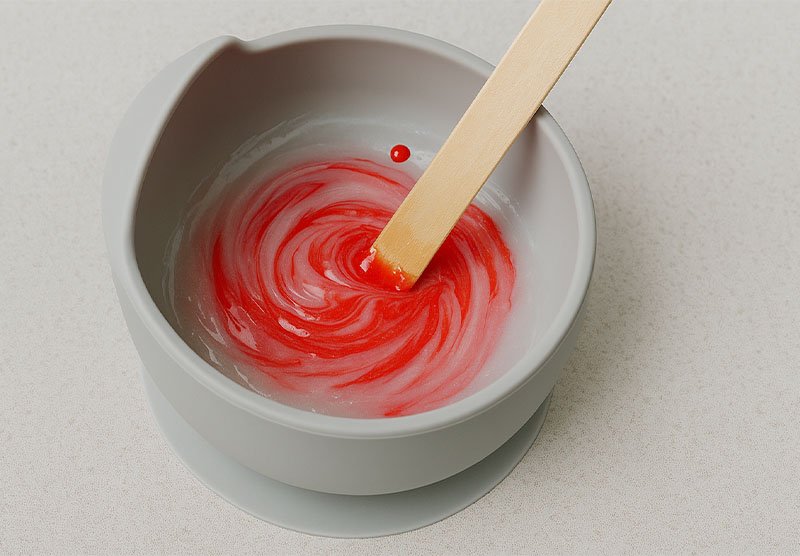Making baby feeding items yourself can be rewarding—but choosing the wrong materials could put your baby at risk.
The best materials for DIY silicone baby products are 100% food-grade silicone, preferably platinum-cured, certified BPA-free, and compliant with safety standards like FDA or LFGB.

If you want to make your own baby bowls, spoons, or teethers, the right silicone matters more than the mold or design. Let’s break down what to use—and what to avoid.
What Is Food-Grade Silicone and Why Does It Matter?
Not all silicone is created equal—some types can release harmful chemicals during use.
Food-grade silicone is non-toxic, heat-resistant, and safe for contact with food, making it ideal for baby feeding products.

Food-grade silicone is made without fillers or plasticizers. It’s formulated to withstand heat and repeated use while staying stable and safe. I always look for FDA or LFGB certification when sourcing silicone, and I never compromise on that. Babies put everything in their mouths—so there’s no room for risk.
Key Qualities of Food-Grade Silicone
| Property | Benefit |
|---|---|
| BPA-Free | Prevents hormone disruption |
| Heat Resistant | Safe for sterilizing and dishwashing |
| Flexible & Durable | Can be molded into different shapes and reused safely |
| Odorless | Won’t absorb smells or release chemical odors |
| Chemically Stable | Doesn’t leach toxins over time |
These traits are essential if you want to create feeding products you can trust.
What Is the Difference Between Platinum-Cured and Peroxide-Cured Silicone?
Two curing methods, one clear winner for baby safety.
Platinum-cured silicone is the better option for DIY baby products because it is purer, more stable, and less likely to leach substances than peroxide-cured silicone.

Curing is the process that turns liquid silicone into a solid material. Peroxide curing is cheaper, but it can leave behind residues. Platinum curing uses a more advanced method that results in higher purity and fewer side effects. I’ve tested both and always choose platinum-cured for our product lines.
Comparison Table: Platinum vs Peroxide Cured Silicone
| Feature | Platinum-Cured Silicone | Peroxide-Cured Silicone |
|---|---|---|
| Purity Level | Very High | Moderate |
| Residue Risk | Minimal | Higher |
| Odor | None | Slight chemical smell |
| Baby-Safe? | Yes | Not recommended |
| Cost | Higher | Lower |
The upfront cost may be more, but safety and peace of mind are always worth it.
Are All Silicone Molds Safe for Baby Feeding Products?
Mold material matters just as much as the silicone you pour into it.
Only use food-grade silicone molds that are certified safe for baking or food use—avoid craft molds or unknown imports.
When I first experimented with DIY silicone feeding sets, I made the mistake of using a cheap mold I bought online. The result? A strange chemical smell that never went away. After that, I only used certified, food-safe molds with clear temperature ratings and safety documentation.
Tips for Choosing Safe Silicone Molds
- Look for molds marked as “food-grade” or “LFGB/FDA-approved.”
- Avoid molds labeled for “resin” or “craft use only.”
- Choose molds that tolerate at least 200°C (392°F).
- Check for certifications or lab test results from the seller.
A safe mold ensures your DIY product is fully safe from start to finish.
Can You Color DIY Silicone Safely?
Yes—but only if you’re using pigments made specifically for food-grade silicone.
Use certified, non-toxic, food-grade silicone pigments that don’t bleed, fade, or contain heavy metals.

Babies love color, and adding vibrant hues can make your feeding sets more fun. But not every dye is safe. Craft pigments, especially those for resin or soap, often contain metals or toxins. I’ve found that the best pigments come from silicone material suppliers, not general craft stores.
Safe Coloring Guidelines
| Step | Best Practice |
|---|---|
| Choose Pigments | Only food-safe, heavy-metal-free options |
| Add During Mixing | Blend evenly while silicone is still in liquid form |
| Test First | Cure a small batch to ensure color holds |
| Avoid Overuse | Too much pigment can alter silicone properties |
Color is great—but only when it doesn’t compromise safety.
Conclusion
For DIY baby feeding products, use 100% food-grade, platinum-cured silicone with food-safe molds and certified pigments—safety must come first in every step.